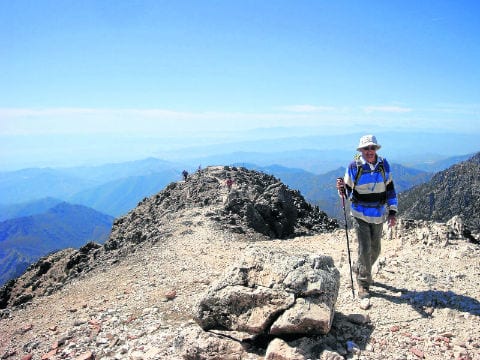WAKING up on the summit of El Lucero is a little like having a ringside seat at the birth of the world.
As the dawn sky shifts from purple to gold, you glimpse the mountains of Africa rising on the horizon above a silver sea.
To the north, pine forests swim in the mists of Granada province, while below stark crags thrust up from dark valleys to catch the first rays of dawn.
Here and there a column of smoke reaches up from a faraway farmhouse or hamlet.
You are high above the Axarquia, the 988-square-kilometre eastern corner of Malaga province.
And El Lucero, a limestone buttress soaring 1,700 metres above sea-level, is as good a place as any to appreciate this region’s natural grandeur.
I had spent the night shivering in the ruins of an old Civil Guard post atop the mountain in order to research a book on the region.
It is one of a number of relics left from the bitter struggle that during the 1940s and early 1950s saw guerrillas vainly attempt to overthrow the Franco regime.
Their leader was a ruthless, charismatic character named El Roberto and legends about him and his band still circulate among the villages of the Axarquia.
For quite a while after his rebellion was crushed, not a lot happened in the Axarquia (which comes from the Arabic sharquiyya, meaning the eastern zone).
While tourists began flocking to Torremolinos and Marbella in the 1960s and 1970s, it slumbered.
Poor communications meant the Eastern Costa del Sol was largely bypassed by travellers.
And that’s the good news.
For this zone largely avoided the worst aberrations of the development boom.
Mass tourism has not swamped it and the jetset has focussed on other parts, thank goodness.
The locals of Frigiliana, one of the least-spoilt villages, seem to have heeded the words of King Juan Carlos when he visited in 1998.
Highly impressed, he commented: “You have a very pretty pueblo. Do everything to conserve it.”
This is also largely the case in villages around the region, including Comares, Riogordo and Sedella.
When I came here first, stepping off the bus in Nerja one December when fewer than a dozen foreigners were wintering in the town, land was selling at about two pesetas a square metre and wine was 10 pesetas a litre.
Great, for the visitor. But not for the locals. A medieval lifestyle prevailed. The nearest hospital was in Malaga well over an hour away up a potholed road and ambulances and dentists were unknown.
No longer. These days the Axarquia is truly part of the 21st century, with all the amenities you could expect… and all the pros and the cons that come with it.
Ancient vines and olive groves have been uprooted to make way for urbanisations and villas.
Hundreds of old farmhouses and village dwellings have been renovated and thousands of northern Europeans have either bought second homes or arrived to live permanently under the sun.
Along the coast apartment blocks have sprouted where once the main crop was sugar cane. Cane was king for 1,000 years, but the last refinery on the coast closed in 2006.
Fortunately, although concrete has scarred parts of the coast, it hasn’t ruined it and inland the Axarquia is still an escapists’ paradise of sleepy villages and dramatic sierras.
By far the largest town is Velez-Malaga, praised by Ibn Battutah, greatest of medieval Arab travellers, as ‘a beautiful city with a fine mosque and an abundance of fruit trees’.
Although now surrounded by modern development, the old town is well worth visiting.
Cervantes passed this way as a tax collector and even mentions Velez in his epic novel Don Quixote.
Nearby is Torre del Mar, once a huddle of poor fishermen’s dwellings.
According to one story, things took off when a local builder built apartments to house a string of Malaga businessmen’s mistresses.
Soon after, the Germans started buying and scores of apartment blocks now line the seafront.
Decent amenities were a long time in coming, but the town has spruced itself up, with an excellent promenade and decent eating possibilities. And now Spanish visitors flock in too.
Just along the coast, the first language at bars and restaurants along the Torrox-Costa seafront would appear to be German.
Torrox insists it has the best climate in Europe, although its neighbours, such as Nerja, are inclined to argue the point.
This all stems down to the high mountain ranges behind that not only help bring cooler breezes in summer, but keep out the cold north winds in winter.
One thing Torrox can legitimately claim: it stages one of the coast’s biggest annual beanos.
On a Sunday in mid-December tens of thousands scoff vast quantities of migas, a belly-filling dish served with torrents of Moscatel wine.
Sweet, high-alcohol wine and raisins are Axarquia specialities.
In autumn you will see grapes laid out to dry on paseros, earthen beds facing south.
No wonder the wine is often termed ‘bottled sunshine’, which you can verify by attending Competa’s celebrated wine festival in August.
Be sure too to try the raisins, a luscious, mouth-watering experience.
And for an idea of the work involved in producing them visit the Museo de la Pasa in Almachar.
On the coast the biggest single reason for the Axarquia becoming an internationally-known tourism venue lies underground: la Cueva de Nerja.
On January 12, 1959, five local boys discovered these vast caverns with amazing rock formations and traces of Paleolithic man.
General Franco himself came to view this phenomenon.
Today in Andalucia only the Alhambra palace in Granada draws more visitors.
The rest of Spain finally woke up to Nerja’s attractions when Verano Azul, a popular TV series, was filmed there.
Talk about a reality show, when Chanquete (an old fisherman in the series) died, Nerja Town Hall flew its flag at half-mast.
And today an oil painting of Antonio Ferrandiz, who played the part, hangs there, while one of the boats from the series takes pride of place in the town.
Often you will hear more English than Spanish in Nerja.
Back in the Napoleonic Wars the British bombarded Nerja’s fortifications into rubble, but the locals don’t hold it against them.
Brits run many local businesses and are the mainstay of tourism.
Without doubt the most spectacular scenery along the Costa del Sol lies beyond Nerja.
From the town’s Balcon de Europa you gaze at mountains which tumble sheer into the azure Mediterranean and the area is now protected as a marine sanctuary, great for snorkelling.
But, for me, the best part of the Axarquia is to be found inland.
Here lies the Spain where my wife and I, after working around the world, finally discovered the ideal place to unpack our bags and take up residence.
As we’d dug our way out of dust traps on the tracks of the Outback, as we’d struggled through the crowded streets of Hong Kong, we’d dreamed of an easy-going place in the sun where we could unwind.
There is no sight more attractive than the cubist dwellings of the Axarquia bathed in golden light
Like many other expatriates, we found the ideal spot.
What matter if the toilet was only a hole in the ground, the roof beams were near to collapse and the house could only be reached up 40 or so cobbled steps.
It was autumn and there is no sight more attractive than the cubist dwellings of the Axarquia bathed in that golden light.
The one we finally found in Frigiliana looked down on a mosaic of carefully-tended fields, irrigated by channels first built by the Moors.
To the rear rose the precipitous slopes of the Sierra Almijara.
It is up here in the heady heights of the Tejeda and Almijara sierras, forming part of a 40,000-hectare nature park, that one can really see the best of the Axarquia.
Once mule trains, charcoal-burners, smugglers and wood-cutters trod the paths through the mountains.
Now they are largely deserted, except for hikers, bikers and bird-watchers.
The last wolf disappeared a century ago, but you can catch glimpses of mountain goats, wild boar, foxes and other wildlife amid these tortuous ranges.
Maroma, the highest peak in Malaga province at 2,068 metres, is often wreathed in cloud, in winter sheathed in snow.
In the past neveros (snowmen) would pack the snow in esparto baskets in summer and bring it by mule to the coast to use for refrigeration.
For Malaguenos, hiking to Maroma’s summit is something of a pilgrimage.
Quite a number trek up at the summer solstice to enjoy the dawn (best to be fit and well-equipped).
Just to confirm that you have made the right choice in coming to the Axarquía, a plaque at the top records: “This mountain is the centre of the world./This mountain like any mountain is a sacred place./That’s why you are here…”
David Baird is the author of several books on the Axarquía, including East of Malaga — Essential Guide, Sunny Side Up — The 21st century hits a Spanish village and Between Two Fires — Guerrilla war in the Spanish sierras (Maroma Press). More information at: http://maromapress.wordpress.com/









